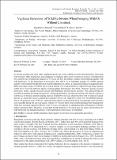Field Margin Vegetation in Tropical African Bean Systems Harbours Diverse Natural Enemies for Biological Pest Control in Adjacent Crops

View/
Date
2019-11-14Author
Mkenda, Prisila
Ndakidemi, Patrick
Stevenson, Philip
Arnold, Sarah
Belmain, Steven
Chidege, Maneno
Gurr, Geo
Metadata
Show full item recordAbstract
Non-crop vegetation around farmland can be valuable habitats for enhancing ecosystem
services but little is known of the importance of field margins in supporting natural enemies of
insect pests in tropical agriculture. This study was conducted in smallholder bean fields in three
elevation zones to assess the importance of field margin vegetation to natural enemy populations
and movement to the bean crop for biological pest control. The pests and natural enemies were
assessed using di erent coloured water pan traps (to ensure the capture of insects with di erent
colour preferences) and the interactions of the two arthropod groups with the margin vegetation and
their movement to the bean crop were monitored using fluorescent dye. Sentinel plants were used to
assess predation and parasitism levels. A total of 5003 natural enemies were captured, more in the
field margin than within the bean field for low and mid elevation zones, while in the high elevation
zone, they were more abundant within the bean field. Pests were more abundant in the crop than
margins for all the elevation zones. The use of a dye applied to margin vegetation demonstrated that
common natural enemy taxa moved to the crop during the days after dye application. The proportion
of dye-marked natural enemies (showing their origin to be margin vegetation) sampled from the crop
suggest high levels of spatial flux in the arthropod assemblage. Aphid mortality rates (measured by
prey removal and parasitism levels on sentinel plants) did not di er between the field edges and field
centre in any of the three elevation zones, suggesting that for this pest taxon, the centre of the fields
still receive comparable pest control service as in the field edges. This study found that field margins
around smallholder bean fields are useful habitats to large numbers of natural enemy taxa that move
to adjacent crops providing biological pest control service.
